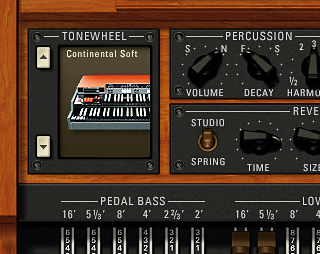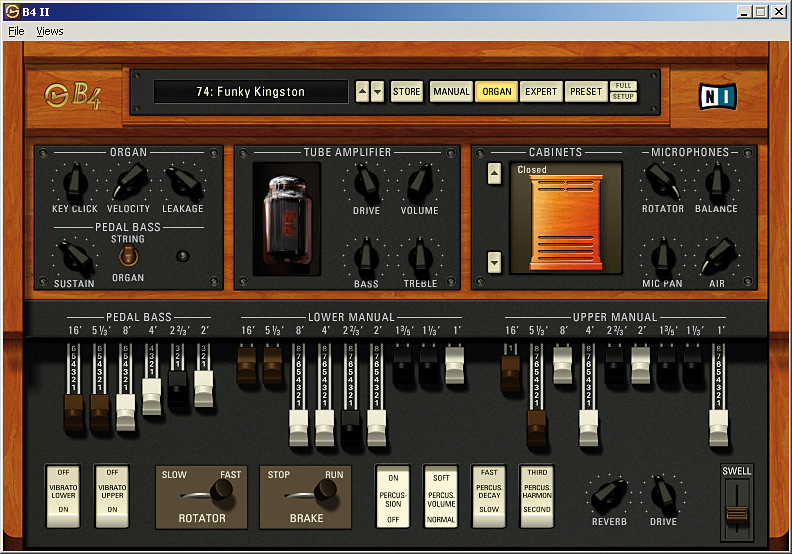MusicRadar Verdict
It may have been around for a while, but B4 still rules the plug-in organ roost.
Pros
- +
Authentic and expressive sound. Intuitive to use. New cabinet models. Alternative tonewheels are built in. New preset browser. Can process any sound.
Cons
- -
Don’t like organ sounds? Don’t buy this.
MusicRadar's got your back



The first version of Native Instruments' B4 Hammond organ plug-in delivered highly musical tones that were wholly true to the sound of the original B3, and became a firm favourite with musicians around the world.
The B4 II spec sheet is full of new features, but do they add anything to the user experience?
New cabinets
A surprising new addition to B4 is the selection of modelled speaker cabinets. You get not just open and closed versions of the Leslie 122 and 147 (the two most popular rotating speaker cabinets), but also some cabinets that are obviously modelled on famous guitar amps.
These include the Vox AC30, Fender Twin Reverb, Roland Jazz Chorus, Fender '59 Bassman, Orange 4x12, Marshall JMP50, Marshall JCM800 and Ampeg SVT II (a DI box is included too).
You could certainly play your guitar through B4 II, but bear in mind that this is only cabinet modelling and not full-on amp simulation. As such, it's no replacement for software like AmpliTube, Waves GTR or Guitar Rig. That said, it's clearly not designed to be.
The reverb implementation in B4 II is particularly interesting. As well as being fully adjustable in terms of depth, time and size, it's also switchable between Spring and Studio, and can even be faded between being before the rotator or after it. This creates the opportunity for some extremely interesting effects.
Want all the hottest music and gear news, reviews, deals, features and more, direct to your inbox? Sign up here.
Tonewheel options
Some things get better as they get older - fine wines, cheeses... and Hammond organs. With B4 II, you can actually 'age' the tonewheel set in various grades, from better-than-new (Pure) to completely worn-out (Trash).
Speaking of cheese, there's no shortage of that with B4 II either. You can now select the Farfisa and Vox Continental tonewheel sets as standard - previously, they were optional extras.
Elsewhere, the rotator itself has been improved. You can fade it in (instead of just having it on or off), Spread is now separately adjustable for bass and treble, and you can even have two top rotors (really!).
There's also a Brake control - very useful when you want to bring the rotor to a complete stop (at the end of a song, for example).
MIDI control is assignable using the now-standard NI method: you right-click a control, select Learn and then twiddle your controller. This is a vast improvement over B4 version 1, in which the controller assignments were all hard-coded.
Also new is the Audition feature. When this is engaged, one of three example MIDI tracks is played continuously - very helpful when you're trying out different presets.
Satisfying
B4 II is hard to fault. We searched long and hard for major problems but simply couldn't find any. An instinctive user interface, sonically-perfect output, and (almost) bug-free plug-in implementation make this one of the most satisfying software instruments currently on the market.
Of course, using the B4 II isn't the same as using a real Hammond, but to be honest, we don't miss the loose Leslie connections, slipping rotator belts or painful back injuries.
This is a virtual instrument that (in many respects) betters the original, and we can't get enough of it.
MusicRadar is the number 1 website for music makers of all kinds, be they guitarists, drummers, keyboard players, djs or producers...
GEAR: We help musicians find the best gear with top-ranking gear round-ups and high- quality, authoritative reviews by a wide team of highly experienced experts.
TIPS: We also provide tuition, from bite-sized tips to advanced work-outs and guidance from recognised musicians and stars.
STARS: We talk to musicians and stars about their creative processes, and the nuts and bolts of their gear and technique. We give fans an insight into the actual craft of music making that no other music website can.
